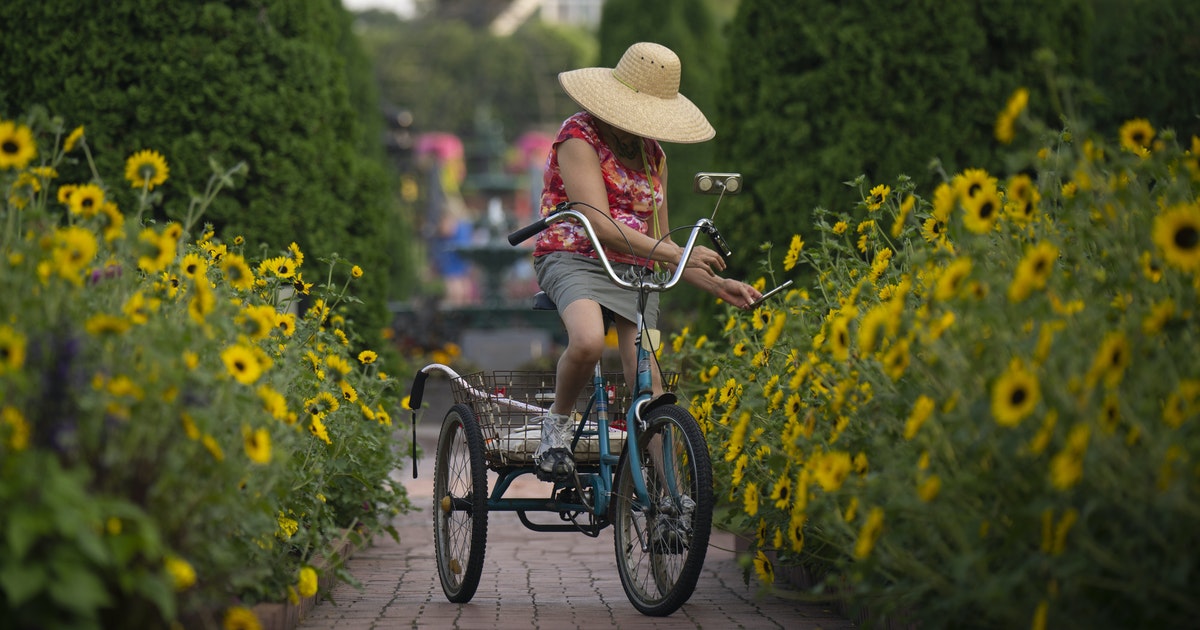A boat whizzes by on the winding Mississippi River, passing acres of vibrant gardens showcasing nearly 100,000 flowers under towering century-old pines.
Monarch butterflies flutter by as chickadees and other birds call out in the sun-drenched treetops, the sweet smell of petunias and hydrangeas wafting through the air.
“It’s beautiful. It’s restful,” says Joan Andersen as she strolls the grounds. “This is one of the gems of our community.”
Tucked in central Minnesota, St. Cloud’s Munsinger and Clemens Gardens sprawl across about 20 acres with rows of colorful blooms, a riverfront gazebo, fountains and four resident peacocks. Of the many public gardens across Minnesota, St. Cloud’s is the only of its kind that hugs the majestic Mississippi.
“We have great views of the river. You don’t see many gardens located along a water bank like that,” says Nia Primus, the gardens supervisor for more than a decade. “It’s a central Minnesota attraction.”
In the fall, bluestem and other grasses transform with silver and red blades while trees glow yellow and orange. Usually by October, crews prep the plots for winter.
While the city-owned gardens draw an estimated 350,000 people a year, including many local visitors and cabin commuters veering off Interstate 94 for a detour, others may be surprised to learn it’s one of the top tourist spots in St. Cloud.
“In general, St. Cloud sort of gets overlooked,” says Penny White, who leads the Friends of the Clemens and Munsinger Gardens, a volunteer fundraising group at the Central Minnesota Community Foundation. “We need to get on the radar. … It’s not just a place you drive through to get Up North.”
Munsinger Gardens is also a key link to the city’s history, named after its first park superintendent, Joseph Munsinger. He designed the park in the 1930s with the help of workers in the Depression-era Works Progress Administration. Before that, a sawmill occupied the land in the 1890s before being replaced with a campground of cabins.
By 1986, St. Cloud added on Clemens Gardens, named after entrepreneur Bill Clemens and his wife, Virginia, who lived across the street from the park and helped fund it. Over the years, Clemens Gardens expanded into six unique gardens across 7 acres — from plots of all white flowers modeled after Sissinghurst Castle’s in England to the Virginia Clemens Rose Garden that shows off about 1,000 roses, her favorite flower.
“It is a really valuable treasure in the community and one that all people can enjoy and find peace,” says White, a lifelong resident who knew Clemens.
Atop a hill that once was a skating rink, Clemens Gardens are more formally designed, with redbrick walkways, a cast-iron treillage, an arbor dome and five elaborate fountains, including one that’s 24 feet tall. In contrast, the 14-acre Munsinger Gardens along the river are shaded by towering Scotch and white pines, with rock-lined dirt paths and bunches of hostas and shade-loving flowers.
The gardens’ location in a former flood plain shelters it from the sounds of the surrounding city, creating a tranquil spot.
“It doesn’t get old,” Primus says of the view atop a staircase overlooking Clemens’ bright beds of yellow daylilies and urns overflowing with bubble gum pink petunias.
This year, three full-time employees, 22 seasonal staff — ages 18 to 80 — and many volunteers planted 82,000 annuals that they nurtured in the city’s 10,500-square-foot greenhouse, helping to ensure that visitors will see different colors and plants each year.
At Clemens, for instance, one garden is rimmed with purple salvia and yellow sunflowers this year — a tribute to Prince, who died five years ago. Another 10,000 perennials and shrubs fill in the grounds.
About two-thirds of the gardens’ costs are funded by the city, with the rest coming from donations, including about $40,000 a year from the Friends of the Clemens and Munsinger Gardens.
Starting at the end of May, crews take six weeks to plant the thousands of flowers. Throughout the summer, they’re busy battling beetles and bunnies, weeding and mowing, before ending the season unceremoniously by pulling out plants over 10 days, usually by October.
Like state parks and so many other public trails, the gardens drew a sudden influx of crowds during the COVID-19 pandemic.
“There’s just steady traffic. You’re not alone if you’re here,” says Andersen, a retiree and self-proclaimed “plant geek” who co-chairs the Munsinger Clemens Botanical Society, an all-volunteer group that plans public events.
The pandemic also led to staffing cuts last year, canceled weddings and halted the site’s annual summer concerts and other special events. This year, staffing returned to normal, concerts were back — and the gardens have been abuzz, dazzling visitors once again. The gardens are free to visit (no dogs allowed) and are open year-round from 6 a.m. to 10 p.m. (Find out more at munsingerclemens.com.)
“It’s really a destination,” says Scott Zlotnik, St. Cloud’s park and recreation director. “It’s certainly a crown jewel for the city.”






